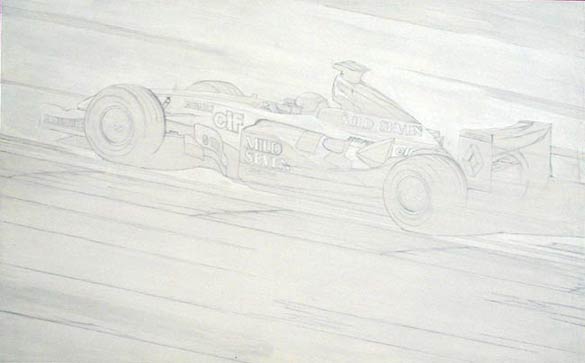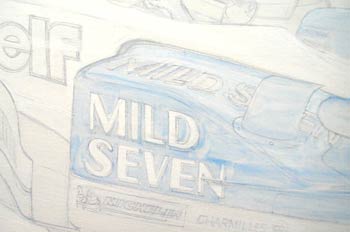
Atlas F1 GP Illustrator
Painting is not only about talent, and the creation process is far more complex that it may appear. There are endless rules, and several do's and don't's that escape the eye of the casual viewer. Atlas F1's GP illustrator Bruce Thomson brings you closer to the experience of creating a piece of art
Then, disaster. I mixed up some of the light blue violet colour for the sidepods and began to apply it. It went on very badly, the gesso seeming to repel the paint. That's not terribly unusual for gesso, especially when you're using the paint as thin as I am for this painting. The first coat looked awful, but I was sure that the initial coat of paint would improve the surface and allow me to get in and work properly, but to my amazement, the second coat, and an experimental third coat all went on just as badly. As you can see the paint isn't lying uniformly at all. You can clearly see the brush strokes and it gives the surface of the car a choppy finish, which is of course the last thing I want. Obviously the gesso is absorbing the paint too quickly and not allowing me to get it spread as evenly as I'd like. I've painted on gesso in this manner before and never had this problem, but that's cold comfort at present. Here's the problem:
When I finished swearing and throwing paintbrushes, I took stock, and came to the conclusion that there were two possible solutions: I could continue the painting on the gesso, but paint opaquely as opposed to transparently; or I could redo the drawing on illustration board. The reason that I didn't use illustration board in the first place , as I think I mentioned last week, is that it has the unpleasant characteristic of bending and buckling when worked really wet. It's not a big problem; it merely has to be mounted when the painting is finished to flatten it out, I figured working on the gesso would save me the trouble of mounting afterward, a matter of an hour or two. I'm going to opt for the second option so that I can preserve the integrity of the concept. So now I have to redraw the entire drawing. Nice. That's about 10 hours down the toilet. Do you know the saying "back to the drawing board"? This is exactly what that means!
This sort of thing doesn't usually happen to me. I KNEW doing this article was a bad idea!
So, gritting my teeth, I begin the drawing again. Once again, I take the sketch, project it on the wall with my portable projector, draw it loosely in and then get it on the drafting board to tighten it up. The full drawing takes me seven hours, and when I've completed it, I'm not to upset about the extra time that has been incurred by the gesso problem, as I think that this drawing is technically stronger than the previous one. Illustration board is a much more forgiving surface upon which to work than gesso and that shows clearly here. The letterforms are much clearer, the linework more precise and the drawing generally a lot "tighter" than the previous one. Finally, I'm ready to apply paint again.
Much better. Now the paint is going on as it should. The first thing I'll do is paint in a single coat of all the blue on the car or Fernando's helmet. As ever, the first coat comes out looking a little "choppy" but I'm not worried this time, as I can see that the paint is doing more of what I expect. Once I've done the second coat, the efficacy of the illustration board is proved. All in all I'll put in about five or six coats of paint on the surface, depending on the darkness or lightness required by specific areas. At this point I'm building up the form by starting to add tone to the painting. Along with the light blue violet that I've used as a base, I've started to work in some ultramarine blue to some of the darker areas and I've flattened the ultramarine blue by adding a little orange.
In the darker areas it's getting hard to read the lettering, so I've lightly painted it in, in titanium white so that I don't have to redraw the letters later. In this type of painting I use the paints straight out of the tube, but apply them so thinly that when I apply one colour on top of another it has the effect of "mixing" the colour on the board due to it's extreme transparency. Last I throw a little red on the helmet as I've got the tube handy.
That's enough tone for the time being. I merely wanted to ensure that I wasn't going to have a problem laying in the thinned paint, and now that I am assured that I will not, I can get into painting in some of the black outline work. I want to do this now because if it's left to last, there is a tendency to underpaint the tones due to the lack of strong outline. As it is, I'm absolutely going to have to come back and darken up the blue considerably. But that sounds like a job for next week.
I've spent 14 hours on the painting this week, for a total of 30 hours. This painting is going to take longer than usual...
Well, so much for getting this done prior to the first race of the year.... I should be farther along than I am but it's been a tough week as far as the painting has gone. If you remember, I was about to re-gesso the surface to lighten the pencil and eliminate some of the smudging. The application of the gesso went smoothly, although I spent a little more time than I really needed to in cleaning up the surface. All told, I spent about three hours getting the painting to a stage where I was ready to apply paint, thus:




|
Contact the Author
Contact the Editor |
Please Contact Us for permission to republish this or any other material from Atlas F1.
|
Volume 10, Issue 11
Atlas F1 Exclusive
Inside View into WilliamsF1 with Gene
Interview with Giorgio Pantano
Articles
Every Other Sunday
The Paint Job: Part III
2004 Malaysian GP Preview
2004 Malaysian GP Preview
Malaysian GP Facts & Stats
The F1 Trivia Quiz
Columns
Rear View Mirror
On the Road
Elsewhere in Racing
The Weekly Grapevine
> Homepage |